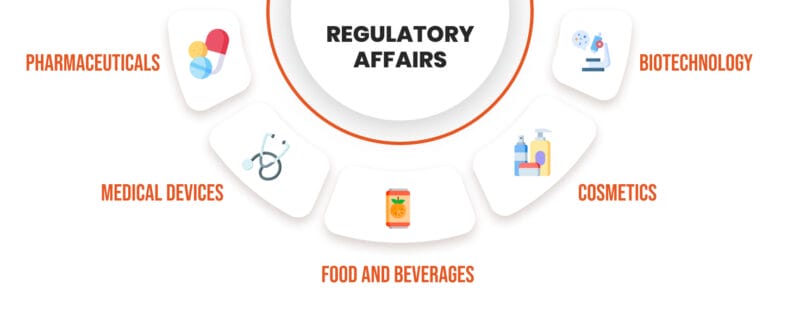In today’s highly regulated industries, compliance with regulatory standards is crucial for business success and public safety. Regulatory affairs professionals play a vital role in managing the complex processes involved in meeting these standards, from product development to market approval.
This article explores the core strategies and best practices essential for navigating the intricate world of regulatory compliance, covering key aspects such as document management, risk assessment, and adapting to global regulations.

An Overview of Regulatory Affairs
The role of regulatory affairs in the pharmaceutical industry is critical for ensuring that drug products meet stringent safety, efficacy, and quality standards throughout their lifecycle. More broadly, regulatory affairs involve ensuring that products comply with all relevant laws, regulations, and standards. This field is essential in industries such as pharmaceuticals, medical devices, food and beverages, cosmetics, and biotechnology. Regulatory affairs professionals manage regulatory submissions, maintain compliance, and minimize legal risks, ensuring products are safe, effective, and high-quality.
Key Areas Covered Under Regulatory Affairs
- Pharmaceuticals: Involves compliance with Good Manufacturing Practices (GMP) and other standards for drugs and biologics.
- Medical Devices: Covers product approval, post-market surveillance, and adherence to ISO 13485.
- Food and Beverages: Focuses on safety, labeling, and compliance with acts like FSMA.
- Cosmetics: Includes ingredient safety and accurate labeling.
- Biotechnology: Involves safety assessments and ethical considerations for GMOs and gene therapies.
Regulatory Bodies and Frameworks
Major Global Regulatory Bodies
- FDA (U.S.): Regulates food, drugs, medical devices, and cosmetics.
- EMA (EU): Supervises medicines across the European Union.
- MHRA (UK): Oversees medicines and medical devices in the UK.
- Health Canada: Regulates health products in Canada.
Differences in Regulatory Requirements Across Regions
Regulatory requirements vary by region, affecting product classifications, approval processes, and labeling. For example, the FDA’s NDA process differs from the EMA’s MAA process.
The Impact of Evolving Regulations on Industries
Regulatory environments are constantly changing, driven by technological advancements and public health needs. New regulations, such as the EU’s MDR or the FDA’s UDI system, require companies to adapt quickly. Staying compliant requires continuous monitoring and strategic planning to navigate changes and seize opportunities in emerging markets.

Core Compliance Strategies
In today’s complex regulatory landscape, organizations must develop comprehensive strategies to ensure compliance and mitigate risks
Develop a Compliance Program
Establishing a comprehensive compliance program is essential for navigating regulatory complexities to adhere to relevant standards. An effective program must encompass clear policies and procedures that align with both regulatory requirements and industry norms. Strong leadership and governance are critical, with a commitment to compliance permeating from the top levels of the organization.
Cross-functional teams are integral to successful compliance efforts. By bringing together expertise from various departments, such as legal, quality assurance, and operations, organizations can create a holistic and coordinated approach to compliance. These teams work collaboratively to identify potential issues, develop solutions, and maintain continuous communication, thereby fostering a culture of compliance throughout the company.
A Compliance Management System (CMS) is another crucial element in a robust compliance program. A well-designed CMS serves as a centralized platform for managing compliance-related information, tracking regulatory changes, and documenting compliance actions. It enhances transparency, accountability, and makes sure that compliance activities are conducted efficiently and effectively.
Risk Assessment and Management
A fundamental aspect of regulatory compliance is the identification and management of risks. This process begins with a thorough analysis of the organization’s operations, products, and the broader regulatory environment to pinpoint areas where non-compliance could arise. Understanding these risks allows for the proactive development of mitigation strategies.
To effectively manage these risks, organizations should conduct regular audits and inspections. These help identify potential compliance gaps. All aspects of the organization’s operations should adhere to the necessary regulations.
Implementing robust controls is also essential to prevent, detect, and correct any instances of non-compliance that may occur. Additionally, having contingency plans in place is crucial for addressing unforeseen regulatory changes or enforcement actions.
Document Management and Record-Keeping
A strong approach to document management and record-keeping is a cornerstone of a solid compliance program. Accurate and up-to-date documentation is vital for regulatory submissions, audits, and inspections. Clear procedures for creating, storing, and retrieving documents are necessary to maintain consistency and reliability. This documentation provides a detailed record of the organization’s decisions and actions, demonstrating compliance and supporting accountability.
Organizations must also implement robust measures to protect sensitive information from unauthorized access and potential breaches. This includes using secure access controls, encryption, and conducting regular audits of data security systems. Electronic record-keeping systems offer significant benefits, such as improved efficiency, reduced manual errors, and streamlined access to essential documents.
Training and Education
Regulatory affairs professionals need to stay current with the latest regulatory updates and best practices. Effective training programs should provide comprehensive education on existing regulations, company policies, and industry standards. These programs should cater to the specific needs of regulatory affairs personnel, offering foundational knowledge and specialized insights.
In addition, promoting compliance awareness throughout the organization is vital. This involves educating all employees about the importance of compliance and their specific roles in maintaining it. A well-informed workforce is more capable of identifying potential compliance issues and fostering a culture of vigilance and responsibility. Regular training sessions, workshops, and updates on regulatory changes play a crucial role in reinforcing the importance of compliance and preparing the organization to respond to regulatory challenges.
How to Navigate Complex Regulatory Environments Challenges
Navigating complex regulatory environments requires a strategic approach, particularly when dealing with global markets. This section explores the challenges and strategies involved in managing international regulations and adapting to regulatory changes.
Challenges in Global Regulatory Compliance
Global regulatory compliance presents numerous challenges due to the diverse and often conflicting regulations across different regions. Companies operating in multiple countries must navigate a maze of regulatory requirements, which can vary significantly in terms of product classification, safety standards, and approval processes. These complexities can create significant barriers to market entry and complicate ongoing compliance efforts.
To address these challenges, organizations must develop strategies for harmonizing compliance efforts across regions. This involves creating a unified compliance framework that aligns with the most stringent regulatory standards while allowing for regional adaptations. Utilizing cross-functional teams with expertise in local regulations can aid in understanding and implementing these varied requirements. For instance, companies can establish a central regulatory affairs team to oversee global compliance while empowering local teams to manage region-specific nuances.
Case studies of successful global compliance strategies often highlight the importance of collaboration and proactive planning. For example, a multinational pharmaceutical company may centralize its regulatory intelligence to monitor changes in global regulations, allowing for timely adjustments to compliance practices. By sharing best practices and lessons learned across regions, companies can streamline their compliance processes and reduce the risk of regulatory breaches.
Adapting to Regulatory Changes
Staying updated with regulatory updates and trends is crucial in a dynamic regulatory landscape. Companies must continuously monitor changes in regulations, such as new safety requirements, labeling rules, or market authorization procedures. Failing to keep pace with these changes can result in costly delays, product recalls, or even legal penalties.
Strategies for proactive adaptation include establishing a regulatory intelligence function within the organization. This team is responsible for tracking regulatory developments, analyzing their potential impact, and disseminating relevant information to stakeholders. By anticipating regulatory changes, companies can adjust their compliance strategies and processes accordingly, minimizing disruption and maintaining market access.
Coursing Your Way To Compliance
To effectively managing regulatory affairs demands a strategic and well-informed approach. Organizations can mitigate risks and maintain high standards by establishing comprehensive compliance programs, keeping detailed records, and staying current with global regulatory developments.
As regulations continue to evolve, staying proactive and adaptable will be crucial for long-term success.

